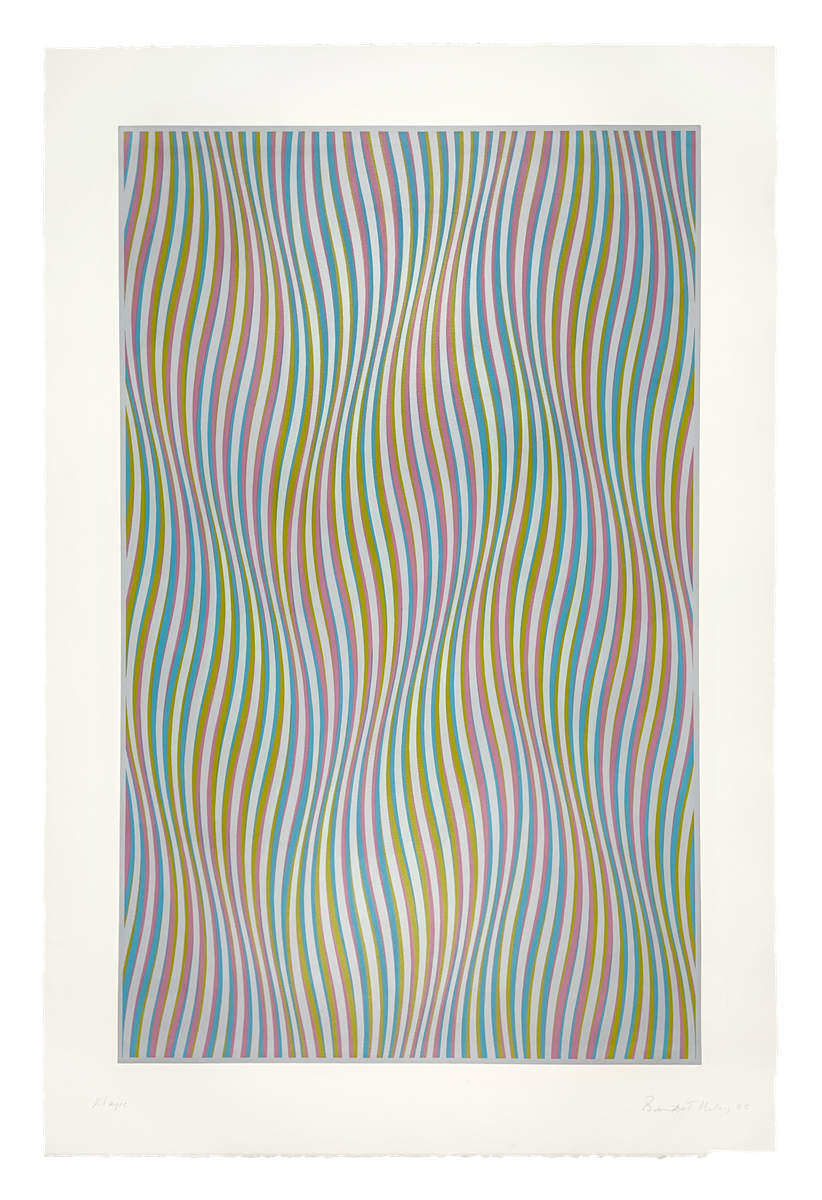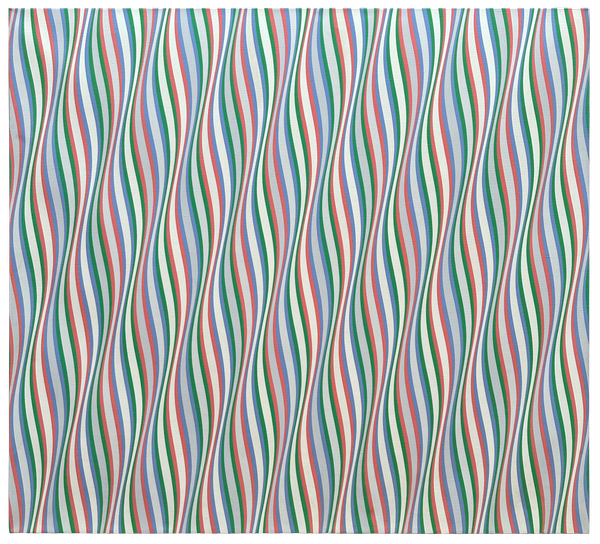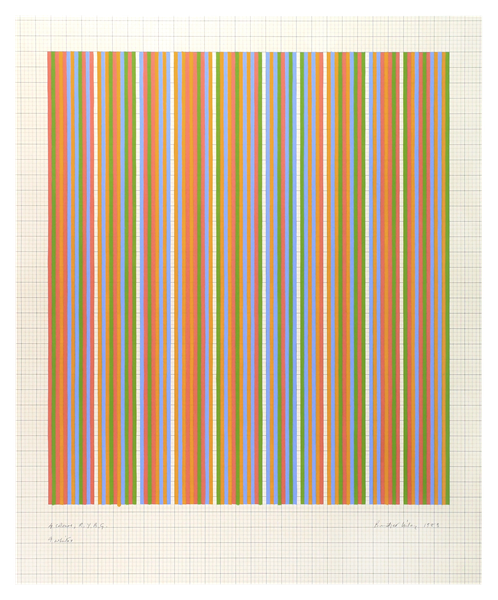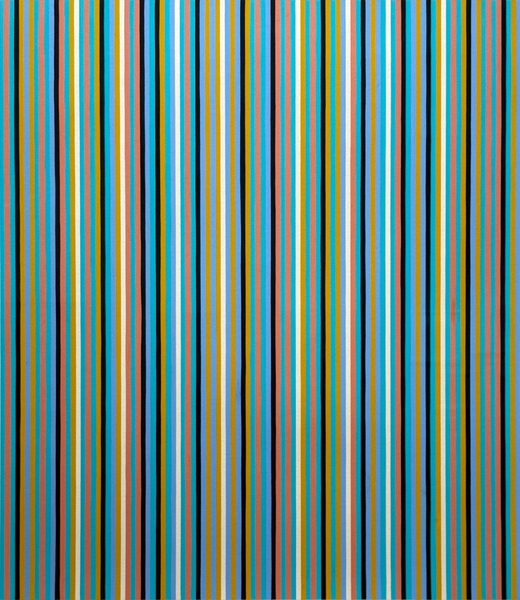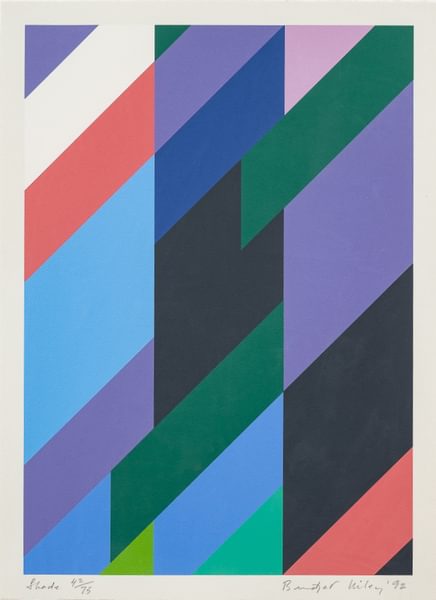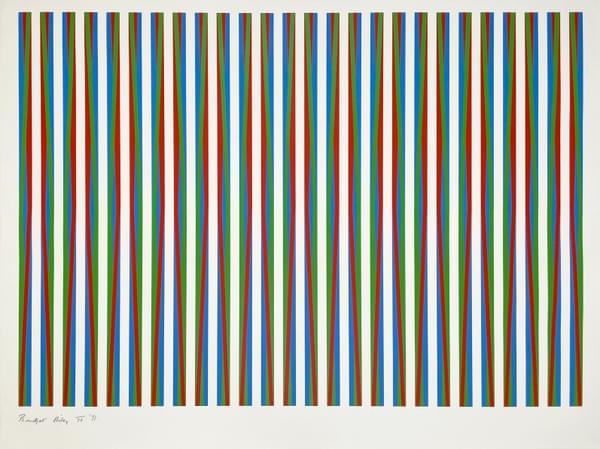Elapse
'I don't paint light. I present a colour situation which releases light as you look at it.'
From 1974 until 1979, the fundamental unit of Bridget Riley's paintings was the curve. A broadening and a deepening of Riley's understanding of the relation of colour and light can be discerned in her curve paintings. The key to this is the role of the curve in creating a more pliable, less assertive structural armature so that occasionally the effect is as delicate as stained glass. This is also a structure in subtle movement. The eye follows the course of a curve and loses the thread as the shapes begin to fuse, dissolving like a rising haze of heat or undulating like ripples on the surface of water. These effects are non-descriptive yet tantalisingly evocative, recalling the patterns and rhythms of nature. They are also deeply expressive.
Before commencing the curves, Riley had observed: 'My paintings are, of course, concerned with generating visual sensations, but certainly not to the exclusion of emotion. One of my aims is that these two responses shall be experienced as one and the same.' The curve paintings include some of the most serene and emotionally radiant that she has ever painted, an implication that blossoms in the connotations of poetry and music contained in some of their titles. The paintings draw the eye into an intoxicating optical experience. The simultaneous contrast of adjacent colours, and the evocation of fugitive colours resulting from optical mixing, build cumulatively. They take the paintings within a hair's-breadth of their overall colour focus being lost. Yet always, within this dissolution, a sense of order remains.
Elapse represents the end of a complex investigation into the vehicle of the twisted curve. Riley produced 10 prints which employed the structure. Coloured Greys [1] and [3] in 1972; Wave in 1975; Green Dominance, Blue Dominance and Red Dominance in 1977; Untitled [Blue], Untitled [Bronze] and Untitled [Rose] in 1978 and finally Elapse in 1982, by far the largest in size and edition.
Having taken the dissolution of colour to an extreme, the reinstatement of a firmer sense of structure now seemed necessary. In 1980, Riley visited Cairo and the Nile Valley and began her so-called Egyptian period, reverting to the structure of the simple stripe in her painted work and in the two prints which directly precede Elapse in her canon. The work was commissioned by the Print Club of Cleveland for distribution to its members, which most likely explains the period "elapsed" between Riley moving to the next phase of her work and the publication of this print.
A copy of this print is held in the permanent collection of the Cleveland Museum of Art and the Sweet Briar College Art Collection, Virginia. The work was illustrated on the private view invitation card for the exhibition Prints - Bridget Riley, Museum in Kulturspeicher Würzburg, in 2019.
Some text bridged from Paul Moorhouse's introductory text to Bridget Riley's Tate Gallery retrospective catalogue, 2000.
Elapse
- Artist
- Bridget Riley (b.1931)
- Title
- Elapse
- Medium
- Screenprint in colours
- Date
- 1982
- Size
- 47 x 31 ¼ in : 119.6 x 79.7 cm
- Frame Size
- 50 x 34 ¼ in : 127.0 x 87.0 cm
- Edition
- From the edition of 250, all of which are unnumbered
- Inscriptions
- Signed, titled and dated by the artist in pencil
- Printer
- Printed by Graham Henderson, London
- Publisher
- Publication commissioned by the Print Club of Cleveland
- Provenance
- Karsten Schubert, London
- Literature
- "Bridget Riley - The Complete Prints 1962-2020", The Bridget Riley Art Foundation, Thames & Hudson, London, 2020, no. BRS 31, pp.132-133 (col. illus.)
Schubert 30 - Exhibited
- Städtische Galerie, Villingen-Schwenningen, 2013
Museum in Kulturspeicher Würzburg, 2019 - Reference
- A22-81
- Download PDF
- Status
- Currently Unavailable
Available Artists
- Albers Anni
- Ancart Harold
- Andre Carl
- Avery Milton
- Baldessari John
- Barnes Ernie
- Calder Alexander
- Castellani Enrico
- Clough Prunella
- Crawford Brett
- Dadamaino
- de Tollenaere Saskia
- Downing Thomas
- Dyson Julian
- Elsner Slawomir
- Freud Lucian
- Gadsby Eric
- Gander Ryan
- Guston Philip
- Haring Keith
- Hartung Hans
- Hayes David
- Held Al
- Hepworth Barbara
- Hill Anthony
- Hitchens Ivon
- Hockney David
- Hutchinson Norman Douglas
- Jenney Neil
- Katz Alex
- Kentridge William
- Knifer Julije
- Kusama Yayoi
- Le Parc Julio
- Leciejewski Edgar
- Léger Fernand
- Levine Chris
- Marchéllo
- Martin Kenneth
- Mavignier Almir da Silva
- Miller Harland
- Mitchell Joan
- Modé João
- Moore Henry
- Morellet François
- Nadelman Elie
- Nara Yoshitomo
- Nesbitt Lowell Blair
- Nicholson Ben
- O'Donoghue Hughie
- Pasmore Victor
- Perry Grayson
- Picasso Pablo
- Pickstone Sarah
- Prehistoric Objects
- Riley Bridget
- Ruscha Ed
- Sedgley Peter
- Serra Richard
- Shrigley David
- Smith Anj
- Smith Richard
- Soto Jesús Rafael
- Soulages Pierre
- Spencer Stanley
- Taller Popular de Serigrafía
- The Connor Brothers
- Vasarely Victor
- Vaughan Keith
- Whiteread Rachel
- Wood Jonas
